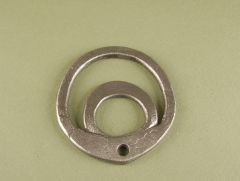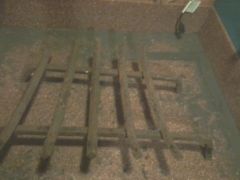-
Posts
85 -
Joined
-
Last visited
Content Type
Profiles
Forums
Articles
Gallery
Downloads
Events
Everything posted by Kal
-
The side sucker is hard to beat. It sits off to one side and doesn't get the the way.
-
-
My 190# HB is tied to a stump with 1/8 cable. Without the cable it is way too loud to be around. I borrowed a 100# Peter Wright for a demo and ended up tying it down with the tie down straps from the truck. At least 2 things you must protect because they're all you get and once damaged they don't heal; eyes & ears.
-
Charles, as another olde fart who couldn't see what he was welding, I discovered that a pair of cheater reading classes under my shield really helped things. Turns out the weld puddle is about the same distance as you hold a book.
-
As one of my co-workers said in his retirement letter : 'If we wait until retirement to enjoy ourselves, there may not be enough of ourselves to enjoy it.' — Mike Hammar
-
All steel is made from remelted scrap. If it came from an electric furnace it is 100% scrap. If it came from a BOP (Basic Oxgen Process) it is 1/3 scrap and 2/3 liquid cast iron from a blast furnace. Whenever a melt shop makes a heat it is done to the spcifics of the order. A36 I believe is low cardon, about 25pts..
-

opinions about this anvil
Kal replied to Ridgewayforge's topic in Anvils, Swage Blocks, and Mandrels
What's with that growth on the horn? -
-
I believe Steve is correct in saying it's a calvary forge. I've seen one other like it but it was pretty pably rusted.
-
I have a couple of bolt pieces that came from a steam engine's boiler. I made a wraped tomahawk with a 1085 bit out of one. The hawk and one other developed a blister like bubble in the surface. I haven't cut into it but it sure looks like the metal delaminated. The hawk with the feather is from wrought iron while the other is plain steel. Both have 1085 bits.
-

Hay-Budden anvil catalogue from 1914/15
Kal replied to Timothy Miller's topic in Anvil Reviews by brand
Petehdgs, thank you for updating this post and bringing it back to the front of the index. I had no idea it was out there. I have 190# HB that like most would not sell for love nor $$$. -

4140 Cracked when hardening
Kal replied to Ancientsword's topic in Heat Treating, general discussion
Back in the day I used to make steel at an electric furnace shop for USS. Most of it was plain carbon but we also made alloy steel. The 41xx, 51xx, and other grades were poured through a vacutum into another ladle to improve the grain/purity before being poured into a final ingot. Wish I had been smithing back then, we had all kinds of steels in the scrap yard. -

4140 Cracked when hardening
Kal replied to Ancientsword's topic in Heat Treating, general discussion
A correction, 4140 does not contain any nickel. It is a chrome and molybdenum alloy with some carbon and manganese thrown in for good measure. -
If you decide to get a cat, try to get one from a litter of 'barn cats'. They will have been taught how to hunt from their mother. The every day city cat has no idea what a mouse is good for, food. It will play with them but not really hunt/kill them. If you use bacon for bait you might catch a blacksmith. :)
-
I got lucky when I was first looking for an anvil. I knew I wanted something with a good ring & rebound to it and of course in good condition. I found this HB at a barn sale for $400. The fellow had 2-3 anvils of various brands and sizes. It's 190# and rings like a church bell. Even when cabled down to a stump it still has quite the ring. Rebound wise, if you miss your work hopefully you're not leaned over too close. I'd like to find another smaller one to travel with.
-
If the piece is small enough to require a handle before forging, be sure and heat it to red before attempting to weld on a handle.
-
Another great class is Jack Wheeler's 'Hammer Useful Heirlooms' class. It will be coming up the first week in February. He has some great ideas for projects in addition to helping you make ideas of your own including tomahawks.
-
My shop has walls of 2x4 studs with T111 siding and even with 2 windows on each side it gets way too hot. My next upgrade is to put some insulation between the studs and sheetrock or more siding on the inside. Basicly make the walls like a real house. I didn't figure on needing insulation in Georgia, at least not form the cold.
-
You can clean the rust off with Muratic acid. That's the same stuff they use to clean excess grout from new tile work. Just soak it in the acid for a few hours. Then clean it with water & baking soda. Be sure and do it outside cause the fumes will get ya and tend to cause other things to rust. I was given an old hammer head that had been in a basement crawlspace for years. Once it soaked the rust off I could read the name on it. Of course any pitting will still be there.
-
Manganese is used in high quanities in the steel that railroad switch frogs are made from. I don't remember the exact precent but it is enough to make them non-magnetic. I doubt that there is a splintering issue, those switch parts take the force of the train changing direction.
-
As said earlier in this string, I would suggest either buying some wolf jaw tongs or finding a set of good tight tongs at a flea market somewhere. I bought my first set of wolf jaws and used them for everything until I got used to forging other simpler things. Now I make my own tongs. My first few sets of tongs were so BAD that I could hardly use them. No one needs that kind of frustration anytime but especially when starting out. My biggest mistake was using too small a stock for the force needed to hold the piece. That and I couldn't get the bits shaped right. Good luck and enjoy
-
It may not be a crack as such. It may be the line where the face plate was attached, forge welded on, when the anvil was built. If it rings the same and the rebound is the same throughout the length of the face I'm thinking it is all right.
-
Something else you can use instead of the S hooks is an adjustable bar. Simply a flat bar with a hook on both ends and a series of spaced holes to raise and lower another hook.
-

New Forge, black smoke, folly and success
Kal replied to SRM's topic in Blacksmithing, General Discussion
Looks like you're off to a good start. I work off a 100 yr old rivet forge that isn't near as nice. An open forge like ours needs to be outside. Most coal will smoke when it's first lit. Once you've got the fire going the smoke will diminish as the cola turns to coke. You can keep some coke (the gray stuff that kind of clumps) to start your next fire. When I start a fire, I like to add a small handle full of fine coal in the first ball of newpaper. Sometimes I'll add a couple of pinecones to the mix.


